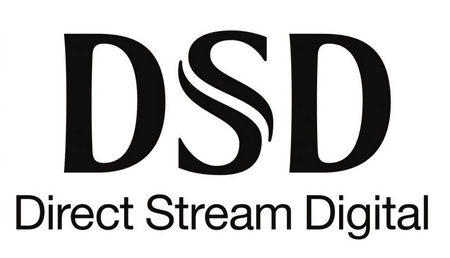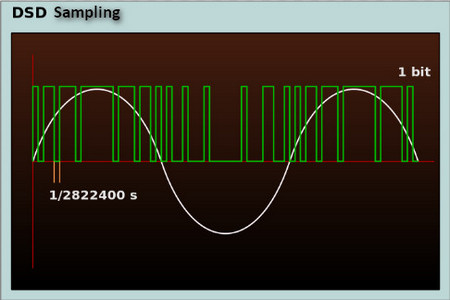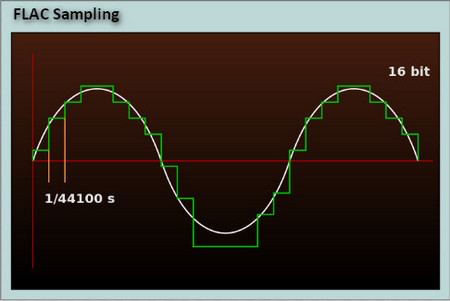![]() by Oswald
by Oswald
Updated on Feb 9, 2023
You might be in possession of some DSD audio files, but you might be unfamiliar with them since they are quite rare indeed. What is DSD? What about it? Compared with the most popular lossless audio format, DSD vs FLAC, which is better? If you are having these queries, keep reading.
 DSD Audio Format
DSD Audio FormatSummary: A digital audio format for niche audiophile with one of the highest resolutions and sample rates.
1. DSD, the abbreviation of Direct Stream Digital, is a trademark originally designed and used by Sony and Philips for Super Audio CD (SACD) but has since become more of a computer-based audio format. DSD audio format can store and play music of excellent quality, which makes it a true audiophile digital format.
2. DSD is similar to PCM (Pulse Code Modulation). But DSD encodes music using pulse-density modulation, and the way DSD music produces hi-res signal is different from the PCM system, of which the way can be transmitted as WAV, FLAC, ALAC or AIFF.
3. DSD is one of the best lossless audio formats. DSD265 used to be the highest audio resolution format among all, and the place is now taken by DSD1024 (the highest standards of DSD so far).
4. DSD audio files respectively stored in .dsf and .dff file extensions.
Now that you’ve obtained the basic concepts, let’s proceed to more details on DSD SACD vs FLAC.
Learn more about lossless audio formats: AIFF vs FLAC | AIFF vs WAV | ALAC Audio Converter
Summary: Both lossless, both excellently good. Hard to tell difference for untrained ears. But DSD performs distinctly better in some Jazz and Classical music.
It’s kind of an unexpected fact that the 1-bit audio bit depth of DSD format, considering the juicy details DSD contains. Note that for every 1-bit increase, the accuracy doubles. But you won’t notice any quiet sound loss compared with Audio CD formats – with 16-bit depth which equates to 96 dB of dynamic range.
Why? Well, two factors shall be given thanks to: The extremely high sample rate – 2.822MHz for DSD64 (64 times of CD sample rate) and the delta-sigma modulation of DSD recorder.
 DSD Sampling
DSD SamplingDSD sample rates (are multiple 44100 Hz, which is CD sample rate):
DSD 64: DSD 2.8 MHz = 2 822 400 Hz = 44100 Hz x 64 times;
DSD 128: DSD 5.6 MHz = 5 644 800 Hz = 44100 Hz x 128 times;
DSD 256: DSD 11.2 MHz = 11 289 600 Hz = 44100 Hz x 256 times;
DSD 512: DSD 22.6 MHz = 22 579 200 Hz = 44100 Hz x 512 times;
DSD 1024: DSD 45.2 MHz = 45 158 400 Hz = 44100 Hz x 1024 times;
See, 64 to 1024 times of CD sample rate is quite astonishing… However, there’s a fact that it’s actually nearly impossible for “untrained ears”, which, as a matter of fact covers most of us, to differentiate between two different hi-res & high sample rate lossless audio formats like DSD vs FLAC. But DSD FLAC comparison makes better sense because DSD is interestingly special.
Speaking of interesting… What matters is the distortion of sigma-delta modulation. I’d say, DSD audio captures audio data in a whimsical regularity. Under limited audio bit depth – a single bit of information in the signal when producing, not much data can DSD capture, but 64 times oversampled signal noise shaping does minimize the noise (intensive noise within high-frequency range reduces sigma-delta modulation stability, DSD push quantization noise up to inaudible ultrasonic frequencies to solve that) and distortion, and result in the perfect music with rich details – The sounds that even make you feel heightened senses of hearing.
 FLAC Sampling
FLAC SamplingLet’s take a look at FLAC then. FLAC covers the range from standard CD 44.1 kHz/16 bit to hi-res 192 kHz/24 bit. Its common bitrate is the same as WAV, 1411kbps. (Unclear concept? 16-bit FLAC = CD quality, 24-bit FLAC = Studio quality). The DSD FLAC sampling difference is obvious, but you can’t conclude just yet. 24-bit FLAC sampling: 192 kHz is only about 5 times of CD sampling, but is still good enough to be qualified as a high-end standard. So, it’s really hard to tell their difference in quality.
Sure, under certain circumstances with high-end audio equipment, DSD overmatches FLAC far and away. By the way, after long hours of 24-bit FLAC vs DSD1024 comparison, FLAC seems more fatiguing. The result of the sampling difference, I figure.
Summary: FLAC is much smaller.
How crucial is size to audio files? Needless to say. You’d agree if you are a music enthusiast with a good deal of audio collection. But that’s actually not fair of a DSD FLAC comparison because DSD wasn’t designed to be a compression format. Audio formats carried on physical mediums (like CD) have a common drawback – large file size, DSD is no exception.
On the other hand, FLAC, specifically designed for efficient packing, is the lossless audio compression format adopting the algorithm that can typically downsize audio file between 40 and 50 percent (an astonishing percentage, you know what, ZIP can only reduce about 10% to 20% audio size) of its original size and decompress to an identical copy, the exact same with the original audio data.
An album of DSD64, DSD128, DSD256, is about 3GB, 5GB, 8GB
An album of 192 kHz/24-bit FLAC music only takes about 1GB.
Once you have cleared the misunderstanding “digital audio quality is not as good as CD” and have realized the fact that digital format is a permanent way of audio storage, to back up your SACD in FLAC format is a terrific plan.
Aside from the quality and file size, there is something else worth mentioning.
1. FLAC is royalty-free and supports metadata.
2. FLAC can be decoded and streamed quickly.
3. Not only is FLAC a perfect digital format for audio storage, but it’s very suitable for transcoding as well. FLAC to MP3, for instance, a widely used conversion for portable device playback.
4. Along with the one-album FLAC music, there are FLAC cue files that help us to split the FLAC audio into multiple tracks.
- While the DSD file format isn’t/can’t.
At last...
DSD or FLAC? I’m sure you’ve got the answer since we’re here – after all those criteria of DSD vs FLAC comparison. The way that I see it is, if really critical about authentic naturalness of the sounds, DSD of course. If not, try that one of the best audio compression formats: FLAC, which can significantly free up your storage, and is compatible with more platforms.